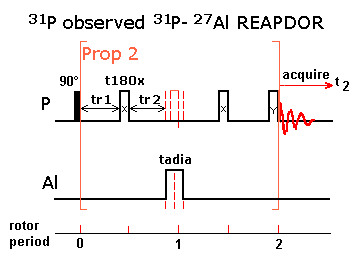Rotational Echo Adiabatic Passage DOuble Resonance, SIMPSON 4.1.1 program

The first simulated signal amplitude in the resulting file provided by this SIMPSON program is S0. The second signal amplitude is that of two-rotor-period REAPDOR experiment.
spinsys {
channels 31P 27Al
nuclei 31P 27Al
dipole 1 2 -439 0 0 0
quadrupole 2 2 2.8e6 0 0 0 0
}
par {
variable index 1
np 32
spin_rate 10000
proton_frequency 500e6
start_operator I1x
detect_operator I1p
method direct
crystal_file rep320
gamma_angles 25
sw spin_rate/2
variable tsw 1e6/sw
verbose 1101
variable rfx 50000
variable rfy 50000
variable t180x 0.5e6/rfx
variable tadia 0.3e6/spin_rate
variable tr1 0.5e6/spin_rate-t180x
variable tr2 0.5e6/spin_rate-0.5*t180x-0.5*tadia
}
proc pulseq {} {
global par
reset
delay $par(tr1)
pulse $par(t180x) $par(rfx) x 0 x
delay $par(tr1)
pulse $par(t180x) $par(rfx) y 0 x
store 1
reset
acq
delay $par(tr1)
pulse $par(t180x) $par(rfx) x 0 x
delay $par(tr2)
pulse $par(tadia) 0 x $par(rfy) x
delay $par(tr2)
pulse $par(t180x) $par(rfx) x 0 x
delay $par(tr1)
pulse $par(t180x) $par(rfx) y 0 x
store 2
acq -x
for {set i 2} {$i < $par(np)} {incr i} {
reset
prop 1
prop 2
prop 1
store 2
acq -x
}
}
proc main {} {
global par
set f [fsimpson]
fsave $f $par(name),$par(index).fid
}
References
Otgontuul Tsetsgee, Solid-state NMR studies on precursor derived Si-B-C-N and B-C-N ceramics.
